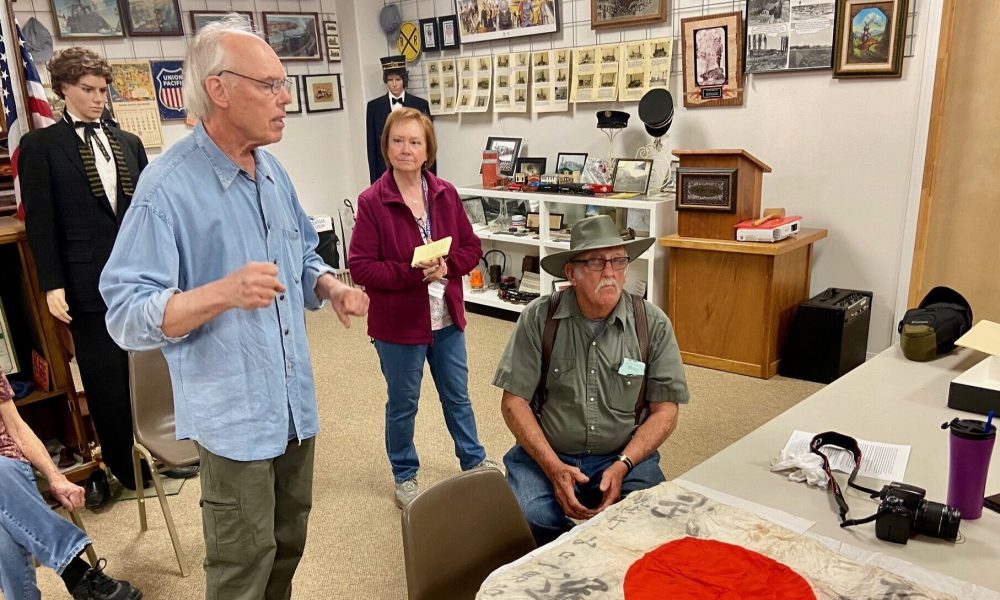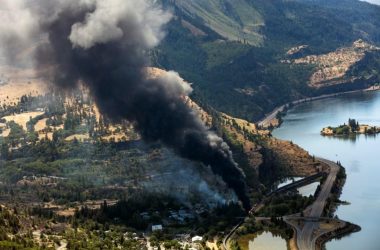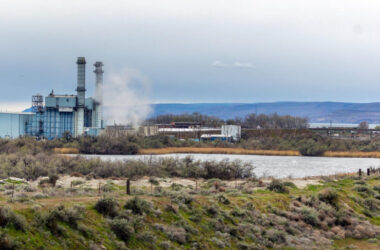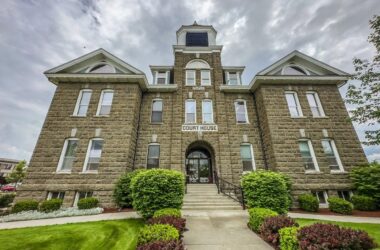GOODING – Among a box full of American flags tucked away at the Gooding County Historical Museum, a mystery from World War II is unfolding.
The 2-foot-by-2-foot piece of cloth is made of silk. Two small leather attachments with string – perhaps used to secure to a flagpole – are stitched to the corners on its left side. With its soft crinkles, light brown stains and black smudges, signs of aging are evident. It must be nearly 80 years old.
It’s immediately identifiable as a Japanese flag; its large crimson circle is centered on the delicate white silk. But what of its characters scrawled in elegant black ink down its left side and in its four corners? What story are they trying to convey?
No one knows how this Japanese flag came into the museum’s collection. It doesn’t include identifying information on who donated it, what it says, where it came from, or even what, exactly, it is.
Phone calls from museum officials were placed to someone who might know more. Ron James, an archaeologist, adjunct instructor of East Asian history at Idaho State University and member of the Twin Falls County Historic Preservation Commission, answered. He knew this piece of cloth had historical significance.
Then, a name scrawled onto the flag was identified: Kazuo Yamaguchi.
More calls were placed. In consultation with Asian American history experts and an Oregon-based nonprofit with a 14-year track record of successfully returning war flags like this to families in Japan, the museum now has an answer on what, exactly, it is.
It’s part of the long tradition of Yosegaki Hinomaru, good luck flags carried by millions of Japanese servicemen, many with signatures of family and townspeople along with notes of gratitude and support, during the war. Japanese families now consider the Yosegaki Hinomaru flags non-biological remains of their loved ones, many of whom were never recovered after World War II, James said.
But museum officials are still stumped on the story behind the man it must have belonged to.
They’re determined to learn more about Yamaguchi’s legacy and reunite the flag with the family members of the soldier who likely carried it with him into battle eight decades ago.
“We are hoping it’ll get back to the rightful owners or the family, you know, and give them, let’s say, a closing,” said the museum’s vice president, Don Mays.
“We know we ought to do the right thing; it’s just the right thing to do,” he added.
Japanese World War II flag found among items waiting to be inventoried at Gooding County museum
In late April, curator Melody Wilkinson was combing through boxes of items donated to the museum, to better inventory its collection.
That’s not unusual. Museum volunteers have slowly been trying to identify items that have been in storage since the museum’s original building’s roof caved in in the 1990s, said Sally Toone, a museum board director and former member of the Idaho House of Representatives.
“It was a scramble to box all of that up from the old museum, and some of that, by the time they built this (museum building) and put displays out, these things were – maybe – at least tagged in the back?” Toone said. “But most of them were not.”
A new museum was built around the year 2007, and the museum’s curators and researchers have been identifying what’s in the collection and unusual items like the Japanese flag ever since.
“To me, it really highlights the importance of the small town museum,” James said. “They are on the front lines of historic preservation. And obviously, not just on local history, because this has national and international significance.”
James began his research on the flag by calling Kurt Ikeda, director of interpretation and education at the National Park Service’s Minidoka National Historic Site. Ikeda knew just whom to reach out to from there, James said, and soon James realized he was talking with a man who knew exactly what the museum had in its collection – and how to bring it home.
Discovery of one flag leads to closure for one family, creation of Oregon nonprofit dedicated helping others find theirs
Rex and Keiko Ziak have been studying, researching and documenting found Yosegaki Hinomaru flags from their Astoria home through their 501(c)(3) nonprofit, the Obon Society, since Keiko’s grandfather’s flag was returned to her family 62 years after he went missing in the jungles of Burma during the war.
“Decades after his death, this memento, a small flag inscribed with the names of family and friends, ended up with a collector in Canada,” according to the Obon Society’s website. “The flag was brought to Tokyo and left at the front desk of a hotel. The hotel staff spent most of a year searching for the owner before finding Keiko’s family.”
Since the nonprofit’s inception in 2009, the couple and their team of volunteers and scholars – in the U.S. as well as Japan – have repatriated more than 900 Japanese items, mostly Yosegaki Hinomaru flags. About 500 of the flags have been directly reunited with family members of the soldiers who carried the flags during WWII.
“We’re to where we don’t have that difference among nations anymore, and people during the war, at that time, brought things to remind themselves of the victory – reminding themselves of the success and surviving the ordeal,” Rex Zaik said. “And now the people who inherit those things, look at them and say, you know, this, this belongs to somebody else.”
Each flag is as unique as the individual that carried it, Rex Ziak said. But many share similar sentiments from loved ones as the soldier was preparing to go to war, Ziak said.
“We will look after your parents until you get home.”
“We’ll take care of the farm until you get back.”
“Be strong.”
“Be loyal.”
“You have one life to give for your country.”
Rex and Keiko Ziak receive small grants from the Japanese government to help cover some of their expenses, such as their internet service, but their work is largely done from the heart – and for free.
Rex Ziak said the nonprofit can find the living relatives of about 20% of the donated flags within four to six weeks, and another 20% in about six to eight months. Other flags can take years to make their way back to the soldiers’ families.
“We have archivists in Japan that receive them,” Rex Ziak said. “They photograph them and catalog them into a database. The database goes to scholars in Japan who study and analyze all of that.”
The scholars read the characters on the flags and look for family names – many that have been in Japan for centuries – references to locales, specific religious shrines or even railroad stamps that designate specific stations where a soldier may have traveled through.
Rex Zaik said these flags are especially meaningful to families because of how the war ended in Japan. After the war’s conclusion, the U.S. government hired 13,000 workers over the course of years to recover the remains of soldiers who were missing in action or who died in combat. Through this effort, about 280,000 servicemen were returned to their American families for burial. But in Japan, thousands of military, political and industrial leaders were arrested and imprisoned for war crimes, and a similar effort to retrieve and reunite the remains of Japanese soldiers never formally took place. Over 1 million Japanese soldiers are still considered missing in action from World War II.
“When we return these flags, people talk to them,” Rex Zaik said. “They say, ‘welcome home.’ They will take the flags that have returned to them, and then they’ll drive and go to the cemetery where their ancestors’ graves are. They will unfurl these flags in front of the graves and show the ancestors that their son has returned home. They’ll show the mother, ‘your son has finally come home.’”
Legion post solving mysteries
The mystery slowly unfolding in Gooding County isn’t so unfamiliar in the North Idaho town of St. Maries, where the veteran members who make up American Legion Lloyd G. McCarter Post #25 have been busy solving decades-old puzzles of their own.
In 2019, local resident Carol Koelbel donated five Yosegaki Hinomaru flags to the post with the hopes of finding answers about who they may have originally belonged to, according to reporting from the St. Maries Gazette Record.
The newspaper reported that Koelbel’s father-in-law, John A. Koelbel, acquired the flags while he was serving in the area of New Guinea during World War II with the Army.
Within four months of working with the Obon Society, Rex and Keiko Ziak’s team was able to find a living relative of one of the flags: Noboru Horiya.
Horiya is the son of Mitaro Horiya, who died in 1944 when his ship came under attack near the Goto Islands in the East China Sea.
His son wrote a letter to American Legion Post 25 Commander Jim Shubert after the flag returned to the family, the St. Maries newspaper reported in 2020.
“I think that the flag has been properly kept and it is unbelievable there is still no discoloration on it after 80 years have passed,” Noboru Horiya wrote, according to the newspaper. “When I saw lots of names and words of encouragement written on the flag by my father’s former teacher, neighbors, friends, relatives, I felt like I was back in a few decades ago.”
Flag donations lead to more Japanese-American connections
The story of the Koelbel family’s donations inspired another local veteran, George Helmstadter, to consider a donation of his own. Now, at least five flags donated to the American Legion in St. Maries have been returned to families in Japan.
Along with his mother, Nancy Helmstadter, the family donated two Yosegaki Hinomaru flags to the post that belonged to his decorated veteran grandfather, Col. Adrian ‘Ad’ Lindsey, that had been folded away for much of the last 80 years.
Lindsey, who worked in the Army’s intelligence division, was awarded the Silver Star and promoted to colonel after being decorated for bravery under fire at Okinawa. In 1949, he became the commander of the 89th Infantry Division. In total, he had 37 years of Army activity before retirement, according to reporting from the St. Maries Gazette Recorder.
Both of the family’s flags, with the help of the Oregon nonprofit, have been returned to Japanese families.
Like the local historians at the Gooding County Historical Museum, Helmstadter, himself a Navy veteran who served during the Vietnam War, said it was the right thing to do to return the flags to their families and home country. At the end of the day, wars are fought between nations by everyday people who are the real victims of those conflicts, leaving loving family members to pick up the pieces, he said.
“I was skeptical at first, thinking that maybe there’s some warmonger souvenir gatherer out there,” he said. “I did kind of question, at first, the validity of the society, because once I let these flags go, what if I wouldn’t ever get a backstory on them? But they were very, very professional and instrumental in making sure that I had a backstory on these flags.”
Rex Zaik said he and wife and the other members of the Obon Society will continue to do this work as long as they are able.
“We as human beings want to always divide ourselves and put ourselves in these different camps,” Rex Ziak said. “These are Russians; these are Ukrainians. These are Japanese; these are Americans. These are Chinese. And these are Jewish, and these are Catholic. But the truth of the matter is, we’re all humans. We all have family. We all have parents. We all have this family love in these connections.”
“It was about a year (after) the Obon Society returned one of the flags that I got correspondence back from Japan from a family member who knew the person who was honored on the flag,” George Helmstadter said. “And then more recently, the second friendship flag was returned to the son whose father wore that flag. The son was in his late 80s. He was just so overjoyed, and at that time, his dad was on Okinawa, and that’s when we were marching our way trying to gain control of the Pacific.”
Christina Lords is the editor-in-chief of the Idaho Capital Sun and has been a professional journalist covering local and state government for nearly 15 years. Idaho Capital Sun is part of States Newsroom, a network of news bureaus supported by grants and a coalition of donors as a 501c(3) public charity.




